|



" The Sodbusters" by Bill Tyree
"The Sodbusters" started as a three
dimensional wood carving. The man, plow, horse and supporting
base form the original wood sculpture. The basswood sculpture
is finished with acrylic media. The wood sculpture has won
awards in gallery shows in Loveland and Fort Collins, the Santa
Fe Trail Association show in Trinidad, Colorado and recently at
a show at the Pioneer Museum in Colorado Springs.
For information about this art contact the artist at bttyreedesigns@aol.com
The "Sodbusters" has been featured at the following juried
art shows
- Art in the Park: Loveland Colorado, 1999
- Thompson Valley Art League: Loveland Colorado 1999
- Northern Colorado Art Association: Fort Collins Co. May 2000
- Sante Fe Trail Association: Trinidad Colorado July 2001
- Pioneer Muzeum: Colorado Springs Colorado November 2001
- Louisville Art Association: Louisville Colorado June 2002
- Boyce Bronze Castings A-list Art Show: Arvada, Colorado June
2002
Historical context of this work of art.
The North American Prairie states in the
late nineteenth and early twentieth century.
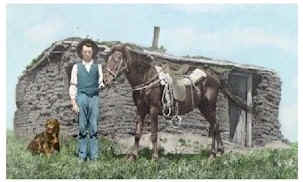
A man his dog and horse in front of a sod house North Dakota Circa
1907
"My childhood was spent in Oklahoma.
I remember when I was seven or eight, at the end of the depression,
horses were still being used to till cotton and corn. Remember that
the thirties were tough times in Oklahoma because of the Dust Bowl
conditions that existed through all of the depression years."
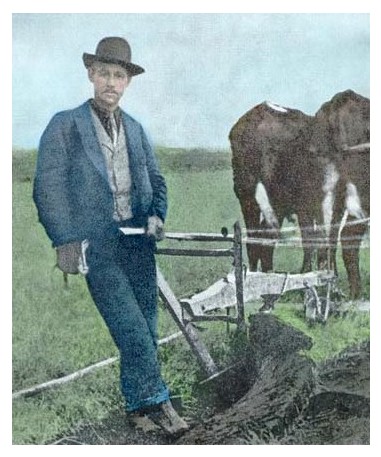
Breaking Sod behind a team of Four" North Dakota 1907
My Dad started out his adult life plowing in Southeastern
Oklahoma and he hated it. That is probably why he became a
teacher. The pictures that show what the prairies of North Dakota
are perfect examples of what the flat parts of Oklahoma are like.
The soil is a different color. Eastern Oklahoma is a lot more hilly
but really rich land. The Cherokee strip land rush was held
to create homesteads before Oklahoma became a state in 1907.

" Four teams of four horses each, plowing a field. Each team
is pulling a walking plow,
with a man following behind. In foreground is turned sod."
In the art work "Sodbusters" I was trying
to capture the lean tough times that people had to live through
during the depression years. Many went hungry but their livestock
got fed because their lives depended upon the survival of
the livestock.
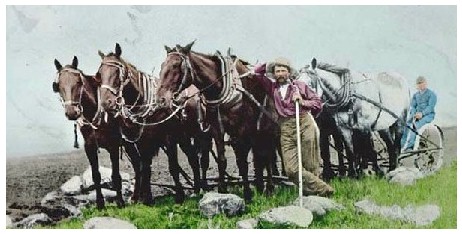
" Breaking Rocky Ground for the first time"

" Having a friendly conversation at harvest time"
When I was in Switzerland in 1995, it was obvious
that the draft horse was still very much a part of basic farming.
Switzerland imports all of its oil. Horses don't require gasoline,
at 5 dollars a gallon." and everything recycles.
Photographs provided by: Fred Hultstrand History in Pictures
Collection, NDIRS-NDSU, Fargo ND courtesy of the Library of Congress
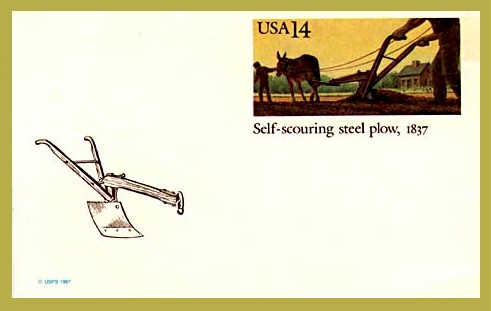
US Postal service commemorative post card issued in 1987
It was not until 1837, when John Deere invented
the self scouring steel bladed plow in Grand Detour, Illinois, that
it was possible to break the prairie sod and farm the prairie on
a large scale.
Scan and information on the plow provided
courtesy of:
Kenneth R. Robertson,
Plant Systematist
Center for Biodiversity
Illinois Natural History Survey
607 E. Peabody Drive
Champaign, IL 61820 USA
See: His Prairie Page http://www.inhs.uiuc.edu/tallgrass
You might be interested in the paintings about
American Prairie Settlement done by Harvey Dunn by showing a
team of oxen plowing the prairie.

The Bronzing Process
Rae Lee Frazier, Steve Boyce and Chester Comstock at Boyce Bronze
Casting, have been my friends and mentors in the process of changing
this original wood sculpture into a finished bronze. I started this
bronze project with the idea that I wanted to do as much of the
process as possible. I wouldn't learn anything if I didn't get involved.
I told Steve that and he only smiled a little when he said "of
course, go for it." I learned how labor intensive the lost
wax process really is. It is a place to get hot, dirty, tired, and
totally immersed in your art. I love the process.
Rae Lee converted the wood sculpture to multiple
molds for the hot wax impressions. She, in her very quiet,
careful way, taught me to pour the hot wax into the mold not on
my hands. Chester regaled me with the stories that make up the life
of an accomplished bronze artist specializing in the world of birds
and antiquities.
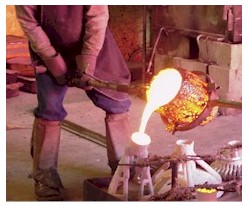 Photo shows Bill Tyree shanking on a pour at Boyce Bronze. Casting
services are the done by the lost wax method of casting using ceramic
shell molding techniques.
Photo shows Bill Tyree shanking on a pour at Boyce Bronze. Casting
services are the done by the lost wax method of casting using ceramic
shell molding techniques.
Pouring molten bronze is addictive.. I hold the
shank end of the pouring fork, the dumb end. Steve controls
the other end, The smart end. There is something very focusing about
holding 100 pounds of molten metal in a crucible radiating
at 2200 degrees temperature and making sure that it goes in the
mold and not on the floor or on your foot.. The beauty of the crucible
color is pure magic.
Come and see for yourself. Steve loves to talk about the bronze
casting world and can show you the wide variety of art that he produces
for his artist clients in his foundry.
|
